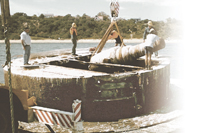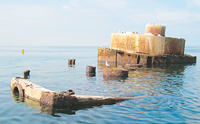 |
|
BIG
LIFT: One of the guns being removed from the aft turret
of HMVS Cerberus.
|
|
Photo:
John Rogers
|
d |
|
FORMER
GLORY: HMVS Cerberus as she appeared at the turn of last
century.
|
|
`Digital
image: ABPH Kade Rogers
|
 |
|
BREAKWATER:
HMVS Cerberus today.
|
|
Photo:
John Rogers
|
New hope has been breathed into the prospect that HMVS Cerberus
be preserved with the dignity that she deserves, given her role
in Victoria’s and Australia’s history.
March 3, 2005, was a blue letter day for Cerberus. All four
guns were removed from their turrets for the first time in over
a century.
As each gun weighs approximately 18 tonnes their removal will
ease the load on the remaining structure by 72 tonnes.
Cerberus was launched in December 1868 at the Palmer Ship building
Company Works at Jarrow on the Tyne River, UK.
Her voyage to Melbourne took five months and she arrived on
April 9, 1871.
Upon her arrival in Melbourne she spent an active and long career
within the confines of Port Phillip Bay.She served for over
50 years – which is a remarkable record for any warship. Cerberus
was flagship of the Victorian Colonial Navy.
She transferred to the Commonwealth naval forces upon Federation
in 1901 and became an inaugural unit of the Royal Australian
Navy, when formed in 1911.
Declared surplus to the Navy in 1924, she was sold to a salvage
company, stripped of any fixtures of value and the remaining
hulk was offered for sale.
Scuttled as a breakwater in September 1926 at Black Rock, Cerberus
has remained there ever since. Regretfully, in December 1993,
a storm triggered the collapse of her hull making it impossible
to refloat her and relocate her.
Marine engineers GHD Pty Ltd have recently completed two reports
on Cerberus and conclude that she can still be stabilised by
lifting her from above, then placing her on an underwater cradle
to return her to the original water line level.
On October 13, 2004 the State Government granted funding of
$80,000 to remove the four guns. March 2005, saw the removal
of the guns.
After being coated with a preservative and also subjected to
electrolysis process the four guns were placed on the seabed.
The salt that has been absorbed by the guns over the years will
leach back into the seawater.
Therefore placing them on the seabed will be a preservation
measure.
Friends of the Cerberus Inc. has worked very closely with Heritage
Victoria, GHD Pty Ltd in addition to the National Trust.
Friends are seeking joint funding from both the Federal and
Victorian State Governments for $5.5 million ($2.75 million
from both the Federal and the State) required for stabilisation
of Cerberus.
However, time is short as Cerberus is in danger of total collapse
from the failure of her main beams that support the weight of
her two turrets – they weigh about 200 tonnes each (even with
the removal of the guns).
The stabilisation works are critical for Cerberus – without
them she will have no future whatsoever.
Such works have a design life of 50 years and require minimal
maintenance. Cerberus would then arise from the waters. Further
details relating to Cerberus and the activities of Friends of
the Cerberus Inc. can be obtained from their website www.cerberus.com.au.

|
Cerberus
was a unique warship and notched up a number of firsts:
|
|
No
sails - masts or yards
Central superstructure
Turrets
at ends of superstructure
Conning tower & vitals protected by an armoured breastwork/citadel
|